10 Examples of Recyclable Materials
Are you curious about what materials can be recycled? Recycling is an integral part of reducing waste and conserving resources. By recycling materials, we can give them a new life and reduce the amount of waste that ends up in landfills or the environment. Here, you will learn about 10 examples of recyclable materials that can be repurposed and reused.
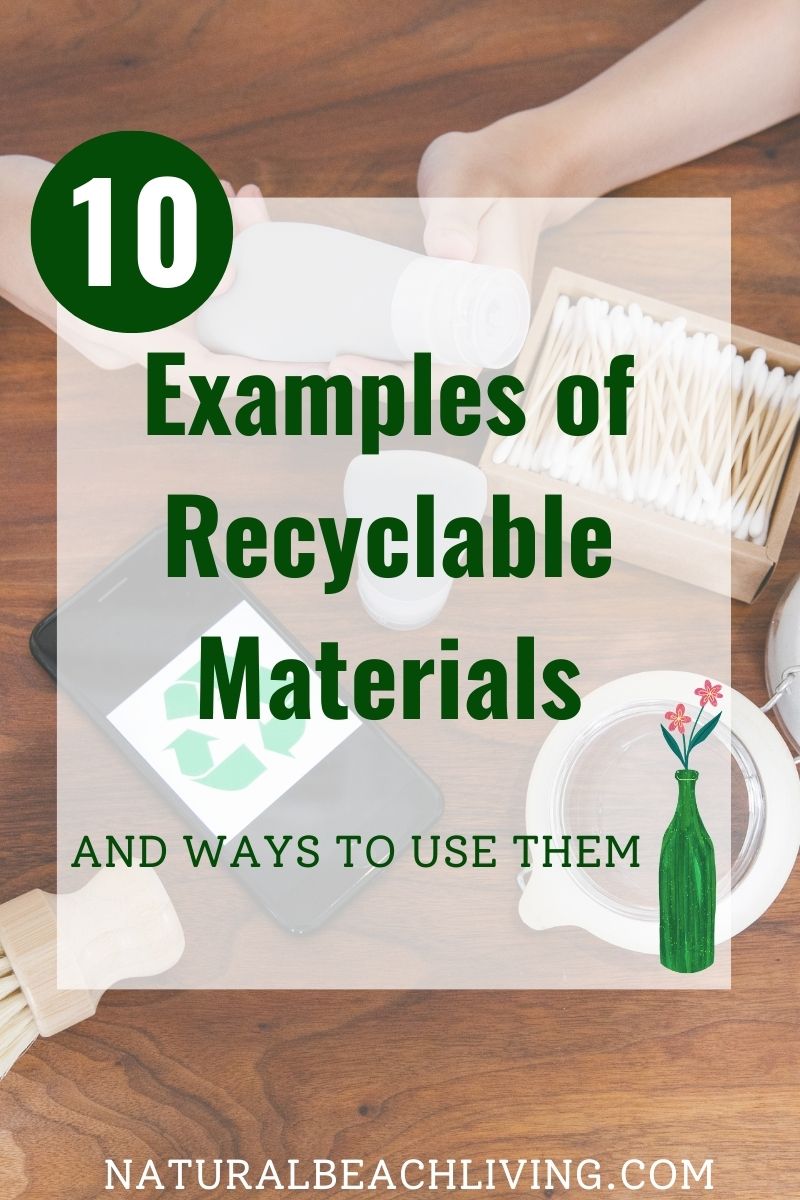
10 Examples of Recyclable Materials You Can Use Today
As moms and teachers, it’s our job to teach the next generation how to care for our environment. And what better way to start than by focusing on recycling? Recycling ensures that non-biodegradable items can be reused rather than thrown away in landfills. It also helps conserve resources while reducing pollution!
affiliate links can be found on this blog at no cost to you.
Examples of Recycled Materials
Here are 10 examples of everyday materials we can all recycle and do our part in making our planet a greener place.
- Cardboard boxes
- Glass
- Plastic Containers
- Plastic and/or Bags
- aluminum products
- Water bottles and soft drink bottles
- Cans
- Paper
- Metals such as copper and iron
- clothing fabrics made of cotton and linen
- Batteries
Recycling is an easy way for families everywhere to contribute towards environmental sustainability with minimal effort – not only does recycling help reduce carbon emissions and prevent new resources from being wasted, but it allows materials that could otherwise be tossed away to be reused instead! Read on as we explore the importance of recycling and the positive effects it can have on your communities!
Understanding Recyclable Materials
Recycling is an important aspect of waste management that helps to reduce the amount of solid waste that ends up in landfills. By recycling, you can help conserve natural resources, save energy, and reduce pollution. But what exactly are recyclable materials?
Recyclable materials can be processed and reused to create new products. They include many materials such as paper, cardboard, glass, metal, and plastic.
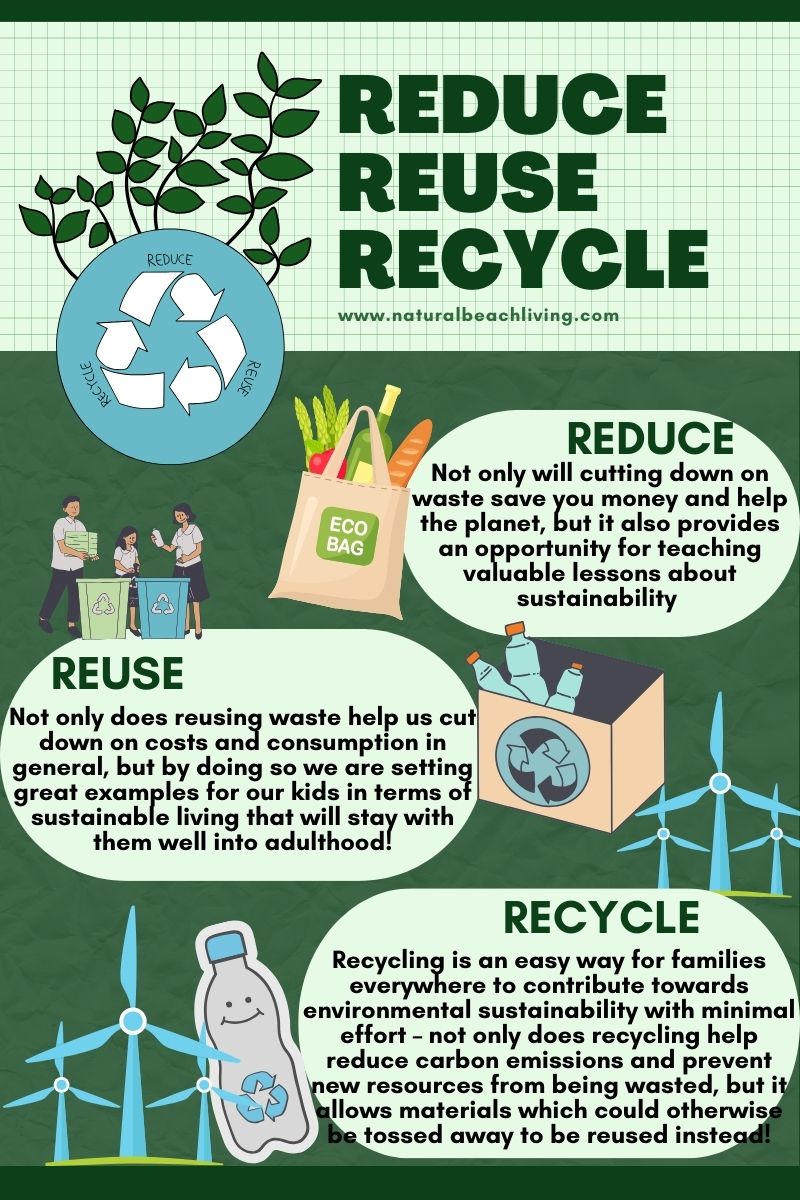
Recycled Materials Examples
One of the most commonly recycled materials is paper. Paper makes up 23 percent of solid waste generated yearly, more than any other material. Recycled paper is used to make new paper products, which saves trees and other natural resources.
Cardboard is another commonly recycled material. It is used to make boxes, packaging materials, and other products. Cardboard can be recycled multiple times and is a valuable resource for the recycling industry.
Glass is also a recyclable material. It can be recycled indefinitely without losing quality. Recycling glass helps to conserve natural resources and reduce energy consumption.
Metal is another valuable recyclable material. It includes aluminum, steel, and copper. Recycling metal helps to conserve natural resources and reduce pollution.
Plastic is a widely used material that can also be recycled. However, not all plastics are recyclable. The most commonly recycled plastics are #1 or PET: clear plastics such as water and soda bottles.
#2 HDPE: typically more opaque plastics such as laundry soap and milk jugs.
#5 yogurt, butter, and sour cream containers.
There are recycling constraints within those figures.
Understanding what materials are recyclable can help you in deciding what you can recycle. By recycling, you can help conserve natural resources, reduce pollution, and protect the environment.
If you can’t recycle it, you can still reuse it. Check out these cool crafts made with recyclable materials.
Not only will cutting down on waste save you money and help the planet, but it also provides an opportunity for teaching valuable lessons about sustainability to yourself and your kids.
Recycled Bird Feeder Plastic Bottle

Plastic Recycling
Recycling plastic is a great way to reduce waste and protect the environment. Many plastic products can be recycled and turned into new products. Below, you will see some of the most common types of plastic that can be recycled.
Plastic Bottles
Plastic bottles, such as those used for water, soda, and juice, are one of the most widely recycled types of plastic. These bottles are typically made from PET (polyethylene terephthalate) plastic, which is a strong and lightweight material. When recycled, PET can be turned into new bottles, clothing, and even carpet.
To recycle plastic bottles, rinse them out and place them in your recycling bin.
Plastic Containers
Plastic containers, such as yogurt, butter, and sour cream, are typically made from HDPE (high-density polyethylene) plastic. This type of plastic is strong and durable, making it ideal for food packaging. When recycled, HDPE can be turned into new containers.
To recycle plastic containers, rinse them out and place them in your recycling bin.
Plastic Bags
Plastic bags, such as those used for groceries and other items, are typically made from LDPE (low-density polyethylene) plastic. This type of plastic is lightweight and flexible, making it ideal for bags and packaging. When recycled, LDPE can be turned into new bags, plastic lumber, and more.
To recycle plastic bags, many grocery stores and retailers offer recycling bins specifically for plastic bags. Simply bring your used bags to the store and place them in the designated bin.
Plastic Wrap
Plastic wrap, such as that used for food storage and packaging, is typically made from PVC (polyvinyl chloride) plastic. This type of plastic is flexible and strong, making it ideal for wrapping and packaging. When recycled, PVC can be turned into new packaging, flooring, and more.
To recycle plastic wrap, check with your local recycling facility for specific guidelines. Some programs may require you to bundle the wrap together before recycling, while others may not accept it at all.
In conclusion, recycling plastic is a simple and effective way to reduce waste and protect the environment. By recycling plastic bottles, containers, bags, and wrap, you can help conserve resources and reduce pollution.
Recycled Bird Feeder

Paper and Cardboard Recycling
Recycling paper and cardboard is an easy and effective way to reduce waste and help the environment. By recycling these materials, you can help to save trees and reduce the amount of waste that ends up in landfills. Here are some examples of paper and cardboard items that you can recycle:
Newspapers and Magazines
Newspapers and magazines are some of the most common paper items that people recycle. These items can be recycled into new newspapers and magazines, as well as other paper products like tissue paper and paper towels. When recycling newspapers and magazines, make sure to remove any plastic wrapping or inserts before placing them in the recycling bin.
Cardboard and Boxes
Cardboard and boxes are also commonly recycled materials. Cardboard boxes can be recycled into new cardboard boxes or other paper products like paperboard. When recycling cardboard and boxes, make sure to flatten them before placing them in the recycling bin. This will help to save space and make it easier for recycling facilities to process them.
Office Paper
Office paper is another common paper item that can be recycled. This includes items like printer paper, copier paper, and notebook paper. When recycling office paper, make sure to remove any staples or paper clips before placing it in the recycling bin. This will help to prevent damage to recycling equipment and ensure that the paper can be recycled properly.
Envelopes and Junk Mail
Envelopes and junk mail are also recyclable paper items. When recycling envelopes and junk mail, make sure to remove any plastic windows or labels before placing them in the recycling bin. This will help to prevent contamination and ensure that the paper can be recycled properly.
By recycling paper and cardboard items, you can help to reduce waste and protect the environment. Make sure to check with your local recycling program to see what types of paper and cardboard items they accept for recycling.
Mason Jar Bird Feeder

Glass and Ceramics Recycling
Recycling glass and ceramics is an important step towards reducing waste in our environment. Glass and ceramics are both made from natural resources, and recycling them can help reduce the amount of energy and raw materials needed to create new products.
Here, we will explore the different ways in which glass and ceramics can be recycled.
Glass Bottles
Glass bottles are one of the most common types of glass that can be recycled. When you recycle a glass bottle, it can be melted down and used to make new glass products. Recycling glass bottles not only reduces the amount of waste in landfills but also saves energy. According to the US Environmental Protection Agency (EPA), making new glass from recycled glass is typically cheaper than using raw materials.
To recycle glass bottles, simply place them in a recycling bin or take them to a recycling center. It’s important to make sure that the bottles are clean and free of any food or liquid residue before recycling them. This helps ensure that the glass can be recycled properly.
Ceramics
Ceramics are another type of material that can be recycled. However, the process of recycling ceramics is more complicated than recycling glass. While ceramics can be melted down and used to create new products, they must first be crushed into small pieces.
Ceramics can be recycled in a few different ways. One option is to take them to a recycling center that accepts ceramics. Another option is to reuse them in your own home. For example, old ceramic plates can be used as saucers for plants, or broken ceramic tiles can be used for mosaics.
In conclusion, recycling glass and ceramics is an easy way to reduce waste and save energy. By recycling these materials, you can help protect the environment and conserve natural resources. Remember to always check with your local recycling center to see what types of glass and ceramics they accept for recycling.
Metal Recycling
Recycling metal is an important way to reduce waste and conserve natural resources. Metals can be recycled repeatedly without losing their properties, making them ideal materials for recycling.
Aluminum Cans
Aluminum cans are one of the most commonly recycled metal products. Recycling aluminum cans saves energy and resources, as it takes 95% less energy to recycle an aluminum can than to produce a new one. Additionally, recycling aluminum cans reduces greenhouse gas emissions and helps to conserve natural resources. When recycling aluminum cans, make sure to rinse them out and remove any plastic or paper labels.
Steel Cans
Steel cans, such as those used for food and beverages, can also be recycled. Recycling steel cans helps to conserve natural resources and reduces the amount of waste that ends up in landfills. Steel cans can be recycled into new steel products, such as cars, appliances, and construction materials. When recycling steel cans, make sure to rinse them out and remove any plastic or paper labels.
Lead Products
Lead products, such as car batteries, can also be recycled. Recycling lead products helps to conserve natural resources and reduces the amount of waste that ends up in landfills. Lead from recycled products can be used to make new products, such as new batteries. When recycling lead products, make sure to handle them carefully, as lead can be toxic.
Overall, metal recycling is an important way to reduce waste and conserve natural resources. By recycling metal products such as aluminum cans, steel cans, and lead products, you can help to reduce the amount of waste that ends up in landfills and conserve natural resources.
Electronic Waste Recycling
Electronic waste, also known as e-waste, is a growing problem in our modern world. E-waste refers to any electronic device that is no longer useful or wanted. These devices can contain hazardous materials that can harm the environment if not disposed of properly. Recycling e-waste is an important way to reduce the amount of waste that ends up in landfills and to prevent the release of hazardous materials into the environment.
Computers and Cell Phones
Computers and cell phones are two of the most common types of e-waste. When you recycle your computer or cell phone, the materials can be used to create new products. For example, the plastic from your old computer can be melted down and used to create new computer cases. The metals in your cell phone can be extracted and used to create new electronic devices.
Televisions
Televisions are another common type of e-waste. When you recycle your old television, the glass can be melted down and used to create new televisions or other glass products. The metals in your television can be extracted and used to create new electronic devices.
CDs and DVDs
CDs and DVDs are another type of e-waste that can be recycled. When you recycle your old CDs and DVDs, the plastic can be melted down and used to create new products. The metal in the CDs and DVDs can be extracted and used to create new electronic devices.
Recycling your e-waste is an important way to protect the environment and reduce the amount of waste that ends up in landfills. By recycling your old electronics, you can help to conserve natural resources and reduce the amount of energy that is needed to create new products. So, the next time you upgrade your electronic devices, be sure to recycle your old ones!
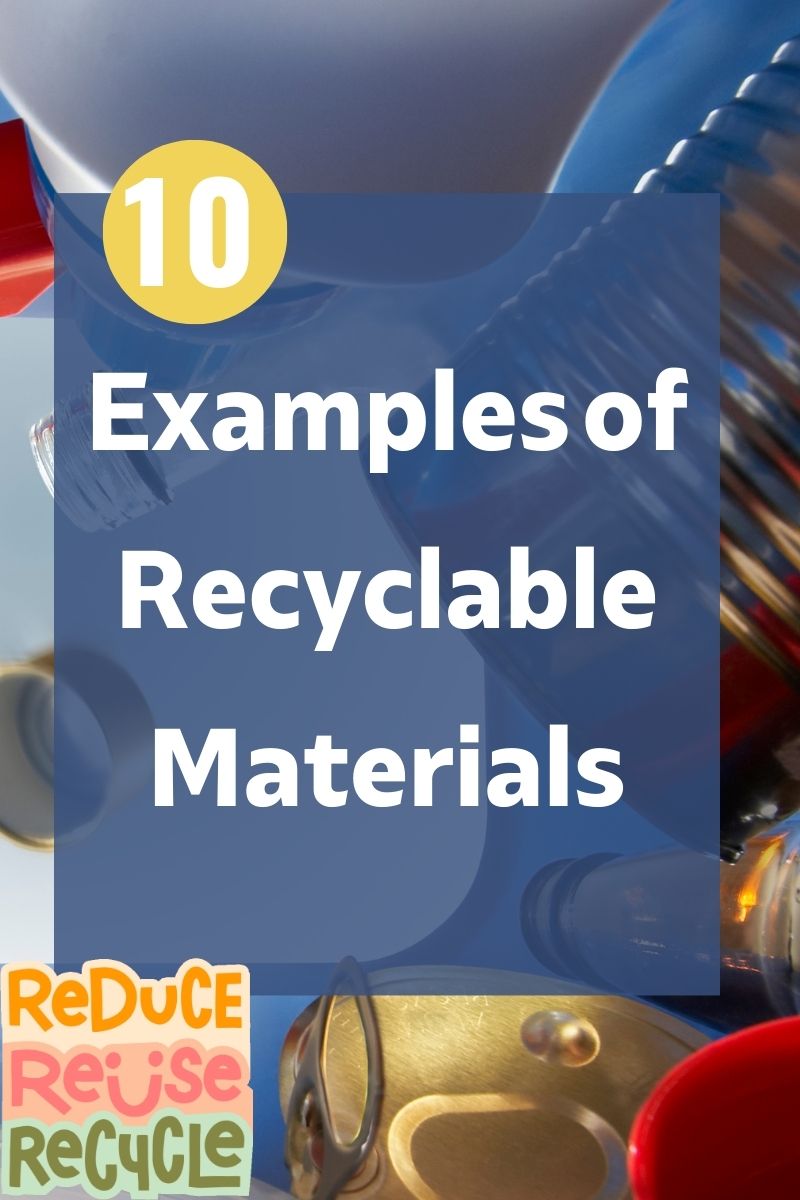
Other Recyclable Materials
Aside from the common recyclables like paper, plastic, and metal, there are other materials that you can recycle to help reduce waste and conserve resources.
Here are a few examples:
Clothes
Did you know that you can recycle your old clothes? Instead of throwing them in the trash, consider donating them to a thrift store or a charity. Many of these organizations will either sell the clothes to raise funds or distribute them to people in need. If your clothes are too worn out to be donated, you can still recycle them. Some cities have textile recycling programs that will accept old clothes and turn them into new products like insulation or carpet padding.
Furniture
When it’s time to replace your old furniture, don’t just throw it away. Consider donating it to a thrift store or a charity. Many of these organizations will either sell the furniture to raise funds or distribute it to people in need. If your furniture is too worn out to be donated, you can still recycle it. Some cities have furniture recycling programs that will accept old furniture and turn it into new products like particleboard or mulch.
Set Up a DIY Outdoor Play Area with Recycled Materials

Tires
When your tires are worn out, don’t just toss them in the trash. Many tire retailers will accept used tires for recycling. The rubber from the tires can be used to make new products like playground surfaces or running tracks. Some cities also have tire recycling programs that will accept used tires and turn them into new products.
Remember, recycling is an important way to conserve resources and reduce waste. By recycling these other materials, you can help make a difference in your community and in the world.
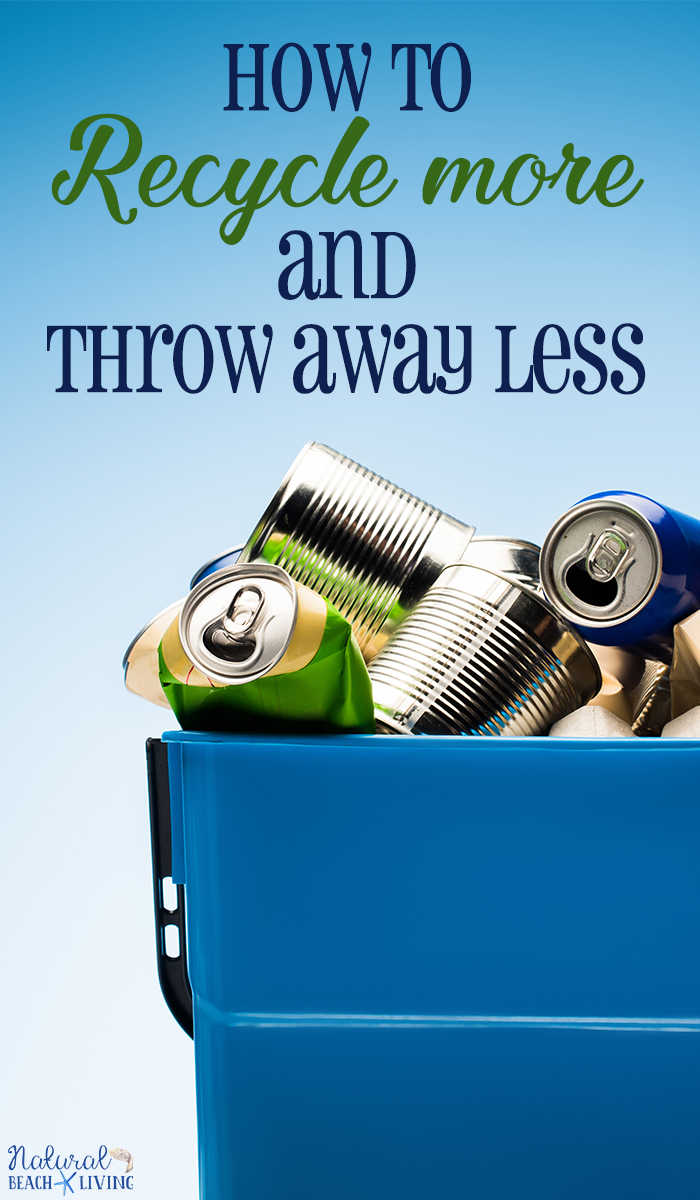
Recycling Centers and Eco-Friendly Practices
When it comes to recycling, it’s important to know what materials can be recycled and how to properly dispose of them.
One way to ensure that your recyclable materials are being handled properly is by taking them to a recycling center. These centers are equipped with the necessary tools and resources to sort, process, and prepare materials for reuse.
Not only do recycling centers help reduce the amount of waste that ends up in landfills, but they also promote eco-friendly practices. By recycling materials, we can reduce the need for new resources and save energy. This is because it takes less energy to recycle materials than it does to create new ones from raw materials.
In addition to recycling, there are other ways to reduce waste and promote eco-friendly practices. One way is to focus on reducing the amount of waste you produce in the first place. This can be done by using reusable containers and bags, buying products with minimal packaging, and composting food waste.
Another way to reduce waste is to upcycle or reuse materials. For example, old clothing can be turned into rags or used as insulation, while glass jars can be used for storage or as vases. By upcycling and reusing materials, we can give them a new life and reduce the amount of waste in landfills.
Overall, recycling centers and eco-friendly practices are important for reducing waste and promoting sustainable living. By taking small steps to reduce, reuse, and recycle, we can all do our part to protect the environment and create a more sustainable future.
Recycled Materials Projects
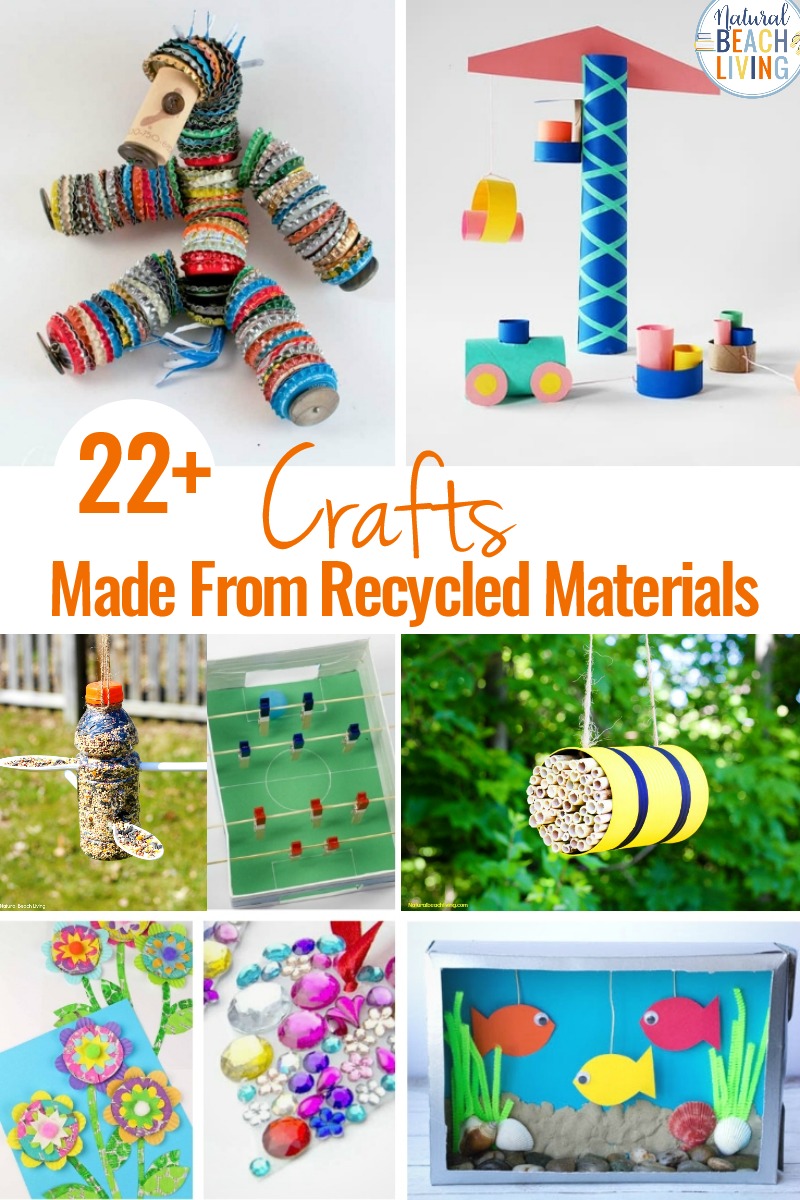
There you go, 10 examples of recyclable materials. By recycling these materials, you can help reduce waste and conserve natural resources.
Remember, it’s essential to dispose of recyclable materials for them to be recycled properly. Check with your local recycling program to see which materials they accept and how to properly prepare them for recycling.
By recycling, you are doing your part to help protect the environment and create a more sustainable future. Keep up the good work!
What can I make out of recycled materials for a school project?
- Birdfeeders
- Birdhouses
- Bug and Bee Houses
- Crafts
- Flower containers, Flower Seed Bombs, and Flower Pots
- Wind chimes
- Aluminum can crafts
- Water Bottle Terrarium
Not only does reusing waste help us cut down on costs and consumption in general, but by doing so, we are setting great examples for our kids in terms of sustainable living that will stay with them well into adulthood!
25 Crafts Made From Recycled Materials
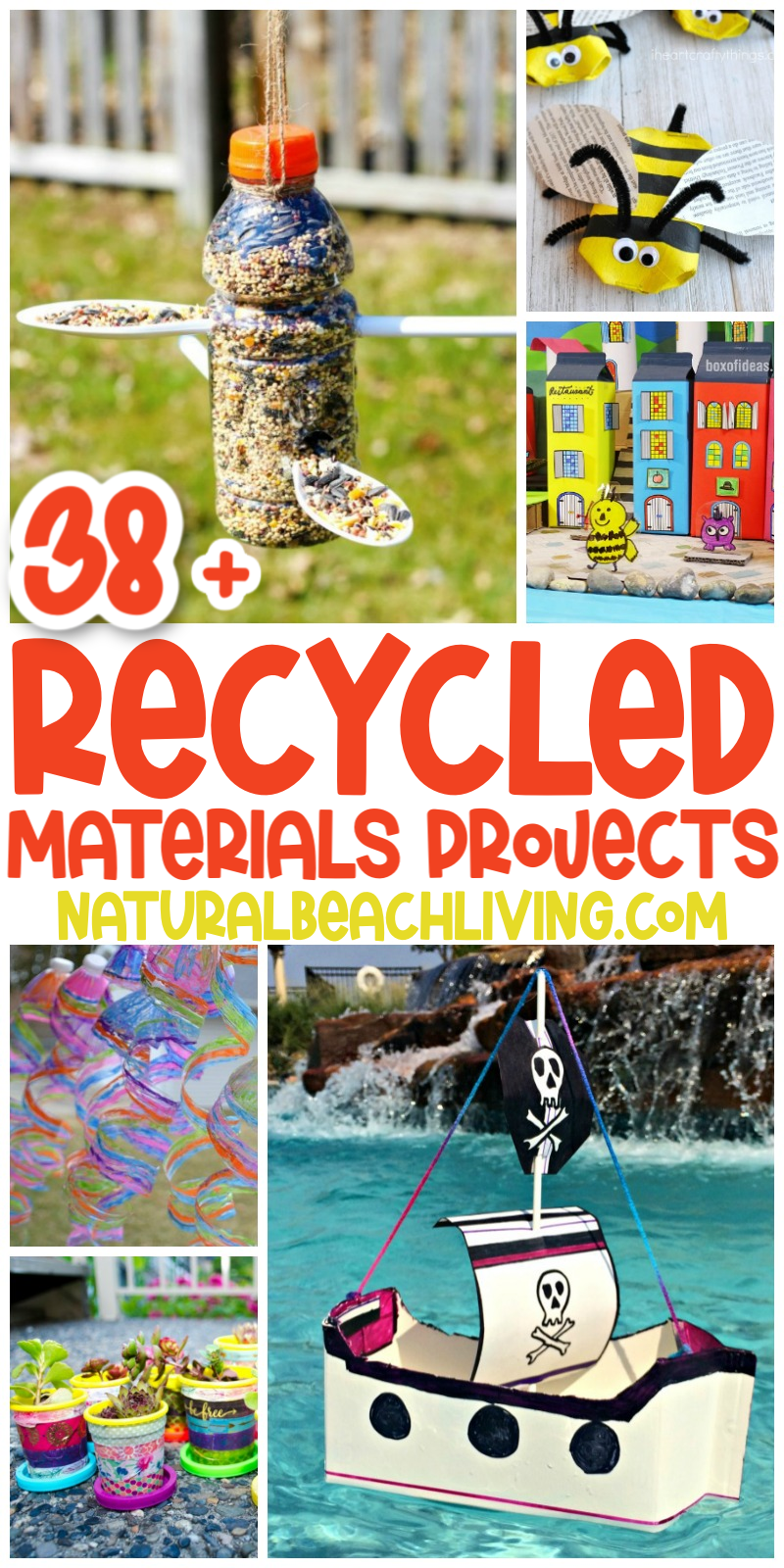
50 Homemade Bird Feeders and Birdseed Ornaments – The Ultimate Guide


